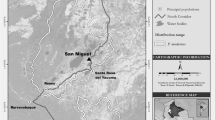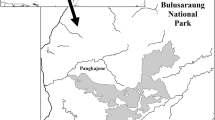Abstract
We investigated behavioral differences among seven groups of northern bearded saki monkeys (Chiropotes satanas chiropotes) living in five forest fragments and two areas of continuous forest at the Biological Dynamics of Forest Fragments Project study area, located approximately 80 km north of Manaus, Brazil. We collected data in six research cycles from July–August 2003 to January 2005–April 2006. When bearded saki monkeys were present in a study area, we followed the group from dawn until dusk for three consecutive days. Every 5 min, we conducted behavioral scans of all visible individuals. There was a positive relationship between forest size and group size, but animals in the small forest fragments lived at greater densities. Bearded saki monkeys in the smaller fragments spent more time resting, less time traveling, and less time vocalizing, but there was no relationship between forest size and the amount of time spent feeding. Our results indicate that the main behavioral differences among the groups are related to the amount of forest resources (e.g., fruit trees, space) available to the monkeys in the smaller fragments, as well as the resulting smaller group sizes. We stress the need to preserve large tracts of forest and provide connectivity between forest patches.



Similar content being viewed by others
References
Achard F, Eva HD, Stibig HJ, Mayaux P, Gallego J, Richards T, Malingreau JP (2002) Determination of deforestation rates of the world’s humid tropical forests. Science 297:999–1002
Allan BF, Keesing F, Ostfeld R (2003) Effect of forest fragmentation on Lyme disease risk. Conserv Biol 17:267–272
Altmann J (1974) Observational study of behavior: sampling methods. Behaviour 48:227–265
Ayres JM (1981) Observações sobre a ecologia e o comportamento dos cuxiús (Chiropotes albinasus e Chiropotes satanas, Cebidae: Primates). M.S. thesis, Insituto Nacional de Pesquisas da Amazônia and Fundação Universidade do Amazonas, Manaus, Amazonas
Benítez-Malvido J, Martínez-Ramos M (2003) Impact of forest fragmentation on understory plant species richness in Amazonia. Conserv Biol 17:389–400
Bicca-Marques JC (2003) How do howler monkeys cope with habitat fragmentation? In: Marsh LK (ed) Primates in fragments: ecology and conservation. Kluwer/Plenum, New York, pp 283–303
Bierregaard RO Jr, Lovejoy TE, Kapos V, Dossantos AA, Hutchings RW (1992) The biological dynamics of tropical rain-forest fragments. Bioscience 42:859–866
Blumberg J (2007) Up in smoke. Smithsonian Mag 38:31
Bonvicino CR, Boubli JP, Otazú IB, Almeida FC, Nascimento FF, Coura JR, Seuánez HN (2003) Morphologic, karyotypic, and molecular evidence of a new form of Chiropotes (Primates, Pitheciinae). Am J Primatol 61:123–133
Boyle SA (2008a) The effects of forest fragmentation on primates in the Brazilian Amazon. Ph.D. dissertation, Arizona State University, Tempe, AZ
Boyle SA (2008b) Human impacts on primate conservation in central Amazonia. Trop Conserv Sci 1:6–17
Boyle SA, Lourenço WA, da Silva LR, Smith AT (2009) Travel and spatial patterns change when northern bearded saki monkeys (Chiropotes satanas chiropotes) inhabit forest fragments. Int J Primatol 30:515–531
Chapman CA (1990) Ecological constraints on group size in three species of neotropical primates. Folia Primatol 55:1–9
Chapman CA, Onderdonk DA (1998) Forests without primates: primate/plant codependency. Am J Primatol 45:127–141
Clutton-Brock TH, Harvey PH (1977) Species differences in feeding and ranging behaviour in primates. In: Clutton-Brock TH (ed) Primate ecology: studies of feeding and ranging behaviour in lemurs, monkeys and apes. Academic Press, London, pp 557–584
Cristóbal-Azkarate J, Arroyo-Rodríguez V (2007) Diet and activity pattern of howler monkeys (Alouatta palliata) in Los Tuxtlas, Mexico: effects of habitat fragmentation and implications for conservation. Am J Primatol 69:1013–1029
Estrada A, Coates-Estrada R (1988) Tropical rain-forest conversion and perspectives in the conservation of wild primates (Alouatta and Ateles) in Mexico. Am J Primatol 14:315–327
Estrada A, Coates-Estrada R (1996) Tropical rain forest fragmentation and wild populations of primates at Los Tuxtlas, Mexico. Int J Primatol 17:759–783
Estrada A, Anzures A, Coates-Estrada R (1999a) Tropical rain forest fragmentation, howler monkeys (Alouatta palliata), and dung beetles at Los Tuxtlas, Mexico. Am J Primatol 48:253–262
Estrada A, Juan-Solando S, Martínez TO, Coates-Estrada R (1999b) Feeding and general activity patterns of a howler monkey (Alouatta palliata) troop living in a forest fragment at Los Tuxtlas, Mexico. Am J Primatol 48:167–183
Ferraz G, Russell GJ, Stouffer PC, Bierregaard RO, Pimm SL, Lovejoy TE (2003) Rates of species loss from Amazonian forest fragments. Proc Natl Acad Sci USA 100:14069–14073
Ferraz G, Nichols JD, Hines JE, Stouffer PC, Bierregaard RO Jr, Lovejoy TE (2007) A large-scale deforestation experiment: effects of patch area and isolation on Amazon birds. Science 315:238–241
Gascon C, Bierregaard RO Jr (2001) The biological dynamics of forest fragments project: the study site, experimental design, and research activity. In: Bierregaard RO Jr, Gascon C, Lovejoy TE, Mesquita R (eds) Lessons from Amazonia: the ecology and conservation of a fragmented forest. Yale University Press, New Haven, pp 31–42
Gascon C, Bierregaard RO Jr, Laurance WF, Rankin-De Mérona JM (2001) Deforestation and forest fragmentation in the Amazon. In: Bierregaard RO Jr, Gascon C, Lovejoy TE, Mesquita R (eds) Lessons from Amazonia: the ecology and conservation of a fragmented forest. Yale University Press, New Haven, pp 22–30
Gilbert KA (1994) Endoparasitic infection in red howling monkeys (Alouatta seniculus) in the central Amazonian basin. Ph.D. dissertation, Rutgers, New Brunswick, New Jersey, USA
Gilbert KA (2003) Primates and fragmentation of the Amazon forest. In: Marsh LK (ed) Primates in fragments: ecology and conservation. Kluwer, New York, pp 145–157
Gilbert KA, Setz EA (2001) Primates in a fragmented landscape: six species in Central Amazonia. In: Bierregaard RO Jr, Gascon C, Lovejoy TE, Mesquita R (eds) Lessons from Amazonia: the ecology and conservation of a fragmented forest. Yale University Press, New Haven, pp 262–270
Hershkovitz P (1985) A preliminary taxonomic review of the South American bearded saki monkeys genus Chiropotes (Cebidae, Platyrrhini), with the description of a new subspecies. Fieldiana 27:1–46
Johns AD, Skorupa JP (1987) Responses of rain-forest primates to habitat disturbance—a review. Int J Primatol 8:157–191
Juan S, Estrada A, Coates-Estrada R (2000) Contrastes y similitudes en el uso de recursos y patrón general de actividades en tropas de monos aulladores (Alouatta palliata) en fragmentos de selva en Los Tuxtlas, México. Neotrop Primates 8:131–135
Kinzey WG, Norconk MA (1990) Hardness as a basis of fruit choice in two sympatric primates. Am J Phys Anthropol 81:5–15
Laurance WF (2001) The hyper-diverse flora of the Central Amazon. In: Bierregaard RO Jr, Gascon C, Lovejoy TE, Mesquita R (eds) Lessons from Amazonia: the ecology and conservation of a fragmented forest. Yale University Press, New Haven, pp 47–53
Laurance WF, Luizão R (2007) Driving a wedge into the Amazon. Nature 448:409–410
Laurance WF, Vasconcelos HL, Lovejoy TE (2000) Forest loss and fragmentation in the Amazon: implications for wildlife conservation. Oryx 34:39–45
Laurance WF, Nascimento HEM, Laurance SG, Andrade AC, Fearnside PM, Ribeiro JEL, Capretz RL (2006) Rain forest fragmentation and the proliferation of successional trees. Ecology 87:469–482
Malcolm JR (1997) Biomass and diversity of small mammals in Amazonian forest fragments. In: Laurance WF, Bierregaard RO Jr (eds) Tropical forest remnants: ecology, management, and conservation of fragmented communities. University of Chicago Press, Chicago, pp 207–221
Marsh LK (2003) Primates in fragments: ecology and conservation. Kluwer, New York
Marsh LK, Chapman CA, Norconk MA, Ferrari SF, Gilbert KA, Bicca-Marques JC, Wallis J (2003) Fragmentation: specter of the future or the spirit of conservation? In: Marsh LK (ed) Primates in fragments: ecology and conservation. Kluwer, New York, pp 381–398
Milton K, May ML (1976) Body weight, diet and home range area in primates. Nature 259:459–462
Norconk MA (2007) Sakis, uakaris, and titi monkeys: behavioral diversity in a radiation of primate seed predators. In: Campbell CJ, Fuentes A, MacKinnon KC, Panger M, Bearder SK (eds) Primates in perspective. Oxford University Press, New York, pp 123–138
Norconk MA, Raghanti MA, Martin SK, Grafton BW, Gregory LT, De Dijn BPE (2003) Primates of Brownsberg Natuurpark, Suriname, with particular attention to the pitheciins. Neotrop Primates 11:94–100
Onderdonk DA, Chapman CA (2000) Coping with forest fragmentation: the primates of Kibale National Park, Uganda. Int J Primatol 21:587–611
Peetz A (2001) Ecology and social organization of the bearded saki Chiropotes satanas chiropotes (Primates: Pithecinae) in Venezuela. Ecotrop Monogr 1:1–170
Rylands AB, Keuroghlian A (1988) Primate populations in continuous forest and forest fragments in central Amazonia. Acta Amazônica 18:291–307
Santos RR (2002) Ecologia de cuxiús (Chiropotes satanas) na Amazônia Oriental: perspectivas para a conservação de populaces fragmentadas. M.Sc. Universidade Federal do Pará, Belém, Pará, Brazil
Saunders DA, Hobbs RJ, Margules CR (1991) Biological consequences of ecosystem fragmentation—a review. Conserv Biol 5:18–32
Silva SSB, Ferrari SF (2009) Behavior patterns of southern bearded sakis (Chiropotes satanas) in the fragmented landscape of eastern Brazilian Amazonia. Am J Primatol 71:1–7
Silva JS Jr, Figueiredo WMB (2002) Revisão sistemática dos cuxiús, gênero Chiropotes Lesson, 1840 (Primates, Pithecidae). In: Livro de resumos: Xth Congresso Brasileira de Primatologia: Amazônia—A última fronteira, Sociedade Brasileira de Primatologia, Belém, Pará, p 21
Terborgh J, Lopez L, Nuñez P, Rao M, Shahabuddin G, Orihuela G, Riveros M, Ascanio R, Adler GH, Lambert TD, Balbas L (2001) Ecological meltdown in predator-free forest fragments. Science 294:1923–1926
Umapathy G, Kumar A (2000) Impacts of the habitat fragmentation on time budget and feeding ecology of lion-tailed macaque (Macaca silenus) in rain forest fragments of Anamalai Hills, South India. Primate Rep 58:67–82
van Roosmalen MGM, Mittermeier RA, Milton K (1981) The bearded sakis, genus Chiropotes. In: Coimbra-Filho AF, Mittermeier RA (eds) Ecology and behavior of neotropical primates. Academia Brasileira de Ciências, Rio de Janeiro, pp 419–442
van Roosmalen MGM, Mittermeier RA, Fleagle JG (1988) Diet of the northern bearded saki (Chiropotes satanas chiropotes): a neotropical seed predator. Am J Primatol 14:11–35
Veiga LM (2006) A ecologia e o comportamento do cuxiú-preto (Chiropotes satanas) na paisagem fragmentada da Amazônia Oriental. Ph.D. dissertation, Universidade Federal do Pará, Belém, Pará
Veiga LM, Ferrari SF (2006) Predation of arthropods by southern bearded sakis (Chiropotes satanas) in eastern Brazilian Amazonia. Am J Primatol 68:209–215
Veiga LM, Silva JS Jr, Mittermeier RA, Boubli J-P (2008) Chiropotes chiropotes. In: IUCN red list of threatened species. Version 2009.1. IUCN 2009. http://www.iucnredlist.org. Accessed 23 June 2009
Wong SNP, Sicotte P (2007) Activity budget and ranging patterns of Colobus vellerosus in forest fragments in central Ghana. Folia Primatol 78:245–254
Acknowledgments
We acknowledge Brazil’s Conselho Nacional de Desenvolvimento Científico e Tecnológico (CNPq), Instituto Brasileiro do Meio Ambiente e dos Recursos Naturais Renováveis (IBAMA), and Instituto Nacional de Pesquisas da Amazônia (INPA) for permission to conduct this research. The Biological Dynamics of Forest Fragments Project (BDFFP), Smithsonian Tropical Research Institute, and Arizona State University provided further logistical and financial support, and the Fulbright/Institute of International Education, Margot Marsh Biodiversity Foundation, Providing Educational Opportunities (PEO), Primate Conservation, Inc., Organization for Tropical Studies, American Society of Primatologists provided additional funding. We thank A. M. dos Reis, O. F. da Silva, W. C. Lourenço, L. R. da Silva, and W. R. Spironello for assistance in Brazil, and E. W. Heymann, L. K. Marsh, and an anonymous reviewer for comments that improved the manuscript. This is publication number 534 in the BDFFP technical series.
Author information
Authors and Affiliations
Corresponding author
About this article
Cite this article
Boyle, S.A., Smith, A.T. Behavioral modifications in northern bearded saki monkeys (Chiropotes satanas chiropotes) in forest fragments of central Amazonia. Primates 51, 43–51 (2010). https://doi.org/10.1007/s10329-009-0169-7
Received:
Accepted:
Published:
Issue Date:
DOI: https://doi.org/10.1007/s10329-009-0169-7




